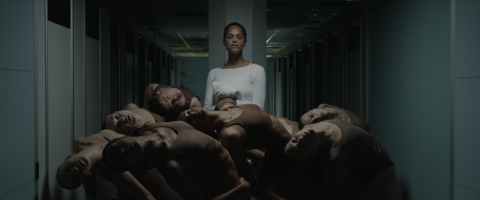Following her graduation from The Dutch Film Academy in 2012, Laura Hermanides has had an intriguing film career that tackles grave subject matter and pressing social issues with artistry and sensitivity. Her work has been screened at EYE Film Amsterdam, Netherlands Film Festival, Cannes Film Festival, and Sundance Film Festival (2016 Shorts Competition Jury Award, Belgium). Her short films, documentaries, and experimental videos explore adolescent sexuality (Nymphet, 2016); politics of power and gender (Trial, 2017); and childhood trauma (Amantea, 2023). Her upcoming feature film debut, The White Flash (2023), may be one of her most psychologically intense productions yet. The film follows a mother whose son suffers from psychiatric problems. He is granted permission for euthanasia, and Hermanides portrays the woman’s sorrow, anguish, and especially the love for her son as she attempts to follow his wishes.
No less urgent, Anahit (2022) uses interpretive dance and a mythological undercurrent to dramatize the experience of a survivor of sexual violence. Based on the true story of Hermanides’s friend Imaani, Anahit opens on a woman’s trepidatious face positioned off the center of the frame. Her hair is drenched and dripping, her eyes give anxious glances, and we hear only her breath trembling faintly. Breath sets the rhythm of the soundtrack, creating an affective dimension that enables the viewer to not only observe but also viscerally and virtually connect with Imaani’s experience. As we accompany the woman, the slowing and quickening of her respiration sets the emotional tenor of each scene.
She then closes her eyes, and Hermanides’s camera transports us to a public swimming pool where the barely clad bodies remind her of the incident. The camera follows the woman from behind into a narrow locker room where a phalanx of dancers writhe in sexually evocative moves. Throughout the video, the dancers respond to her memories and perform her mental and emotional states. They are outfitted in muted earth tones, allowing the viewer to focus on the dancers’ gestures while evoking the hidden, silent suffering of sexual assault survivors.
Making her way through the claustrophobic corridor of the locker room, the woman apparently becomes overwhelmed by the flood of her memories. She and the dancers collapse into the pool. As they slowly come to, breathing heavily, they seem to be possessed by the titular divinity. Anahit is an ancient goddess of water. Like many aquatic deities, her powers and characteristics reflect the multivalency of water. A source of life, water is cleansing and restorative, while also dangerous and destructive, and all these interpretations come to bear in the depiction of Imaani’s trauma.
Anahit also is the goddess of wisdom and healing and thus impels the woman to revisit the incident as a means of recovery. In the following climactic, tension-filled scene, we watch the confrontation between the woman and her aggressor. They engage in a sharp, staccato dance expressive of his ferocity and her fearful struggle against him. As she attempts to resist his touch, with brusque, forceful moves, the man simulates the grabbing, pushing, and striking of her body. Left beneath a running showerhead, the woman stares out in shock.
She and the dancers then enact the emotional aftermath through movement. Their dance is an eruption of fury and indignation, a purgative process accompanied by searing beats and the exertion of their breath. The fervent dance leads them to exhaustion and a seeming breakthrough conveyed by stillness, self-composed stances, and defiant gazes at the camera.
The final shots of Anahit take us back to its beginning, where we once again observe the woman’s face, but now with her eyes reopened in a look of resolve. Having worked through the episode, she is in recovery, and, in the following scene, no longer subject to the camera’s gaze. Instead, we see from her point of view, following her gaze upward at the sun from the pool. Apparently relaxed, her view bobs in and out of the water, but Anahit ends above the surface within a beam of light, refusing to suppress the rise of her body, nor the depth of her feelings. –Kanitra Fletcher
---
Anahit by Laura Hermanides will screen in Landmarks Viewing Room, located at BWY 304. Viewings will be held each Thursday in September from 10AM–4PM, and by appointment. To schedule, please email info@LandmarksUT.org.

